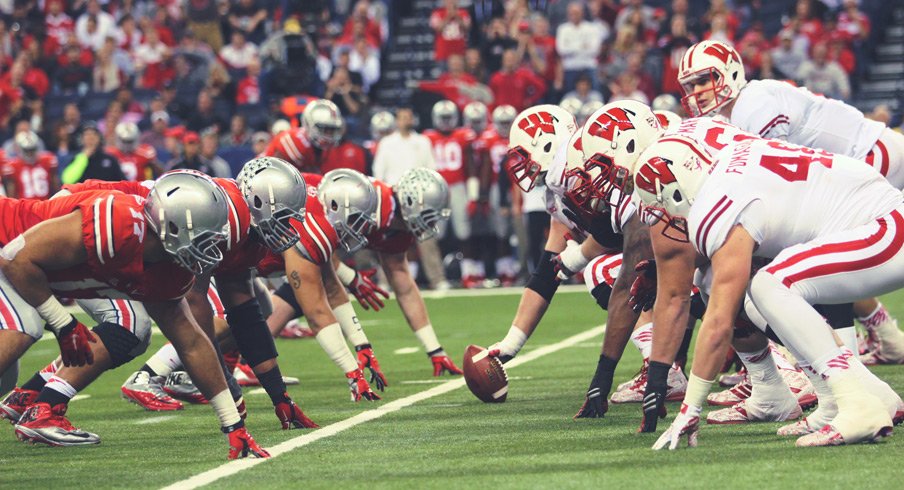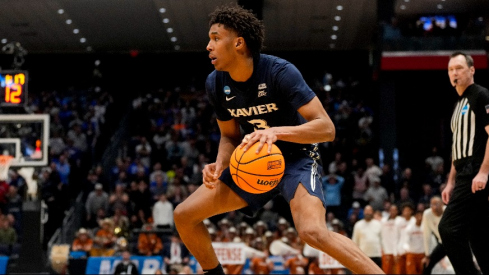Marcus Mariota should invite Larry Johnson Sr. to New York City.
As Melvin Gordon headed into the Big Ten Championship last Saturday night, his Heisman campaign had as much momentum as did his Badgers, who came into the game on a seven-game winning streak.
Gordon had been the engine that drove the winning streak, running for nearly 1,000 yards in the previous four games alone, and was a major reason why Wisconsin was favored by four points heading into the contest. But someone forgot to tell the Buckeyes defensive line that they weren't supposed to be able to stop him. From the very first series on, the front wall of the Ohio State defense put their stamp on the outcome of the game, banking on superior athleticism and technique to beat their counterparts on the Wisconsin offensive line.
Facing 3rd and four on their very first possession of the game, Wisconsin called a staple concept of their offense, the off-tackle "Power" play. After the snap, Gordon would wait for lead blocks from his fullback, pulling left guard, and backside tight end, all of whom should have given the Badgers more blockers on the right side as he looked for a hole between the right tackle and tight end.
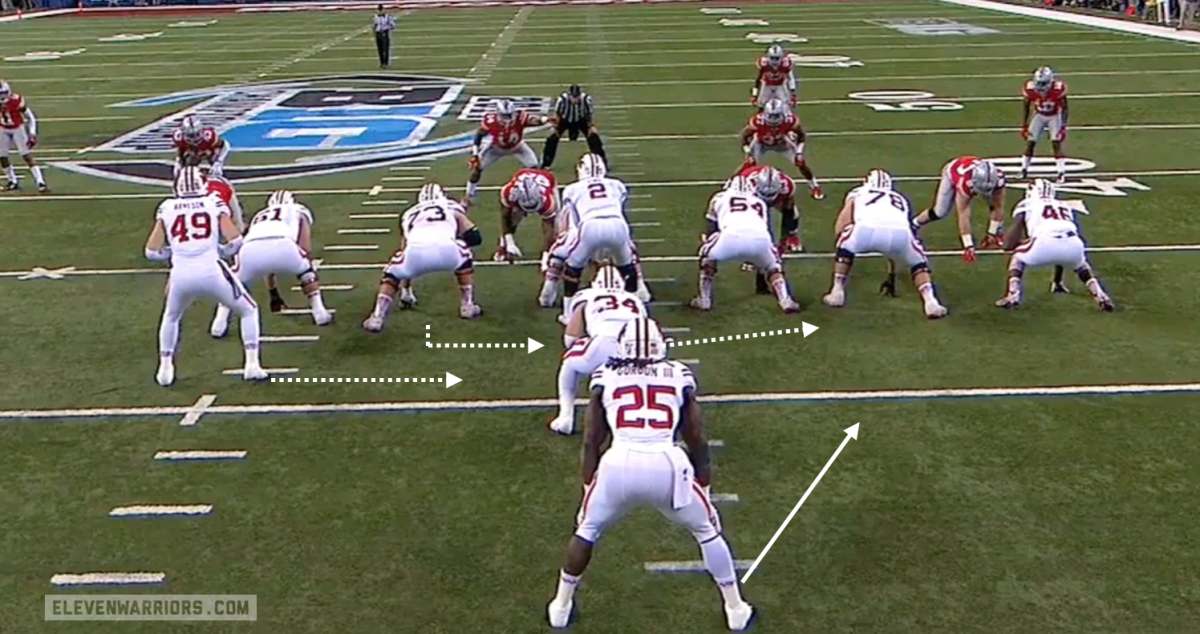
But knowing the Badgers often ran to the side of tight end Austin Traylor (#46), the Buckeyes aligned their 4-3 Over to his side, then slanted across the face of the opponent directly across from them. Before Gordon even got the ball, both Adolphus Washington and Michael Bennett beat their blockers to the very hole they were trying to protect. The duo got such a good jump off the snap that they moved an entire gap laterally, as Washington moved from the center's left to his right, while Bennett did the same to the right tackle (#78).
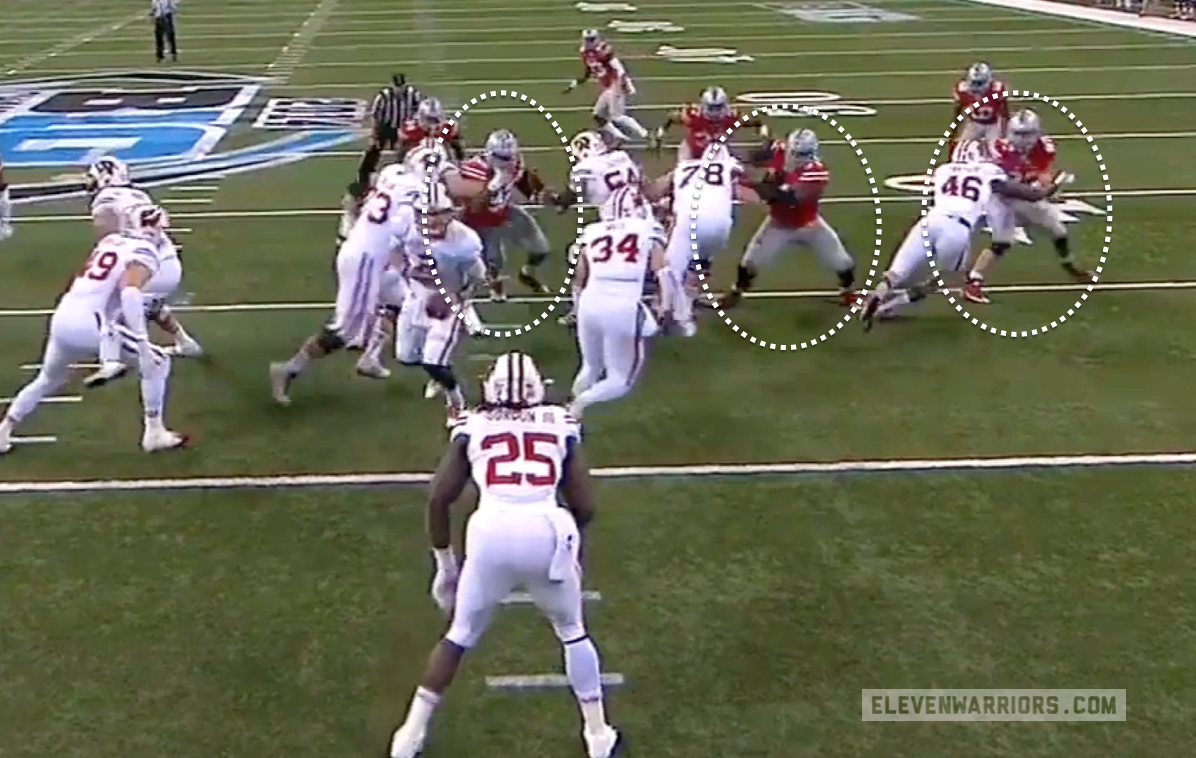
The pair of OSU defensive tackles would not only beat the blockers initially responsible for them at the snap, but also take on and re-route those lead blockers who, on a chalkboard, would lead Gordon through the hole and take on the OSU linebackers. With Washington and Bennett taking on nearly half the Badger offensive line on their own, no one was there to block Joey Bosa after he beat his man. The play resulted in a one-yard loss and forced the Badgers to punt the ball away after a quick three-and-out.

As the game went on, these Buckeye defenders continued to penetrate gaps up front. Regularly finding themselves in the backfield and making a play on Gordon, the Silver Bullets often forced him to move laterally in the backfield and look for a new running lane before picking up any momentum, becoming much easier to take down. Bennett and Bosa constantly found themselves at the center of the action, such as when they combined to force a fumble and return it for a touchdown late in the first half.

But their success wasn't due to luck, or simply because of a scheme adjustment. They, and the rest of the Buckeye defensive front, consistently beat the Badger offensive line thanks to the use of their hands.
Wisconsin has a long and storied history of producing NFL talent on the offensive line, and the tradition appeared to have continued this fall with Gordon's record-breaking season on the ground. However, OSU defensive line coach Larry Johnson Sr. left his stamp on the game with the way his unit consistently batted away the punch technique that is taught by the Badger staff.
Unlike the double-under technique taught to Ohio State offensive linemen, the punch technique calls for an offensive linemen to get his outstretched, inside hand on the outside number of the man they're blocking. The Buckeye defensive line is much taller and quicker than most of the teams the Badgers have faced though recently, forcing them to lunge and be more likely to lose their balance when trying to get that first hand on the their opponents.
Bosa, Washington, Bennett, and others consistently swatted away these punches, not only keeping the Badgers from locking on to their blocks, but also often falling off-balance with their weight transferred too far.
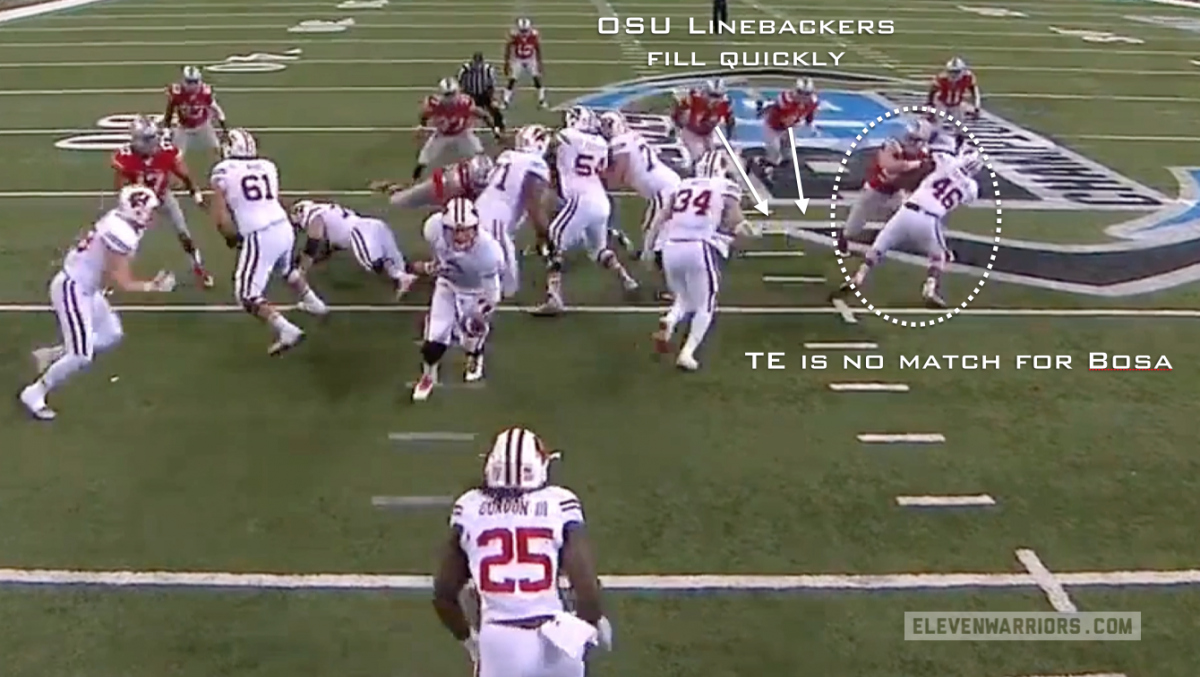
This group was also aided by the linebacking corps behind them, who quickly flowed to gaps, plugging holes at the line of scrimmage and rarely allowing the Badgers to engage in blocks past the line of scrimmage. In this example, Bosa once again beats Traylor off the line and is free to make a play in the backfield thanks to Curtis Grant, who creates a pile to occupy the fullback and pulling backside guard.

As the game went on and the OSU offense continued to put up points, the Badgers were forced to pass. Unfortunately for them, they found the same result, as the Buckeyes consistently got pressure on Wisconsin quarterback Joel Stave. Though Bennett was credited with two sacks on the evening, the credit should be shared with the entire group, as lesser-known players like Rashad Frazier made plays of their own.
Though he didn't actually take Stave down on this play, Frazier (#17) does an excellent job of driving his blocker backwards without committing too hard to one side and allowing his opponent to push him right out of the play. Once he is within striking distance, the former walk-on disengages with a simple swim move, pulling his right arm over the head of his opponent while using his left hand to push him away.

The swim move not only allows Frazier to disengage with his opponent, but forces Stave to tuck the ball away instead of looking to throw, becoming a sitting duck for Bennett to take down. Though the Badgers weren't a great passing team to begin with, the OSU secondary's job was made easier by the fact that Stave was getting pressure when the Buckeyes only sent four rushers, allowing seven defenders to cover receivers downfield.
This performance spoke volumes about the teaching ability of Johnson though, who not only instilled these techniques in his unit, but got strong efforts from backup players like Frazier, Tommy Schutt, and Chris Carter, a group that had been called out earlier in the season by Urban Meyer for not contributing.
As the narrative of SEC dominance in college football emerged over the past decade or so, superior defensive line play was often cited as a major reason for that conference's continued success. Entering the college football playoff, it's hard to argue that any of the other three teams involved, or any team in the country for that matter, have a unit playing as well as Johnson's group is right now.
Just ask Melvin Gordon.
